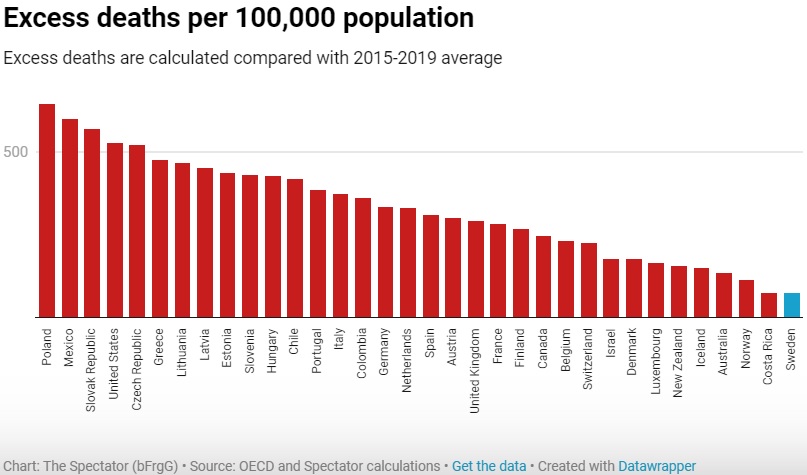When I write about Sweden, it is usually to point out the nation’s schizophrenic approach to public policy – very bad on fiscal issues but very good in other areas like trade, regulation, and monetary policy.
Though there are even some good Swedish fiscal policies, such as personal retirement accounts and no death tax.
Heck, Sweden even became a poster child for my Golden Rule back in the 1990s.
Today, though, we’re going to focus on Sweden’s libertarian-ish approach to the coronavirus pandemic. And we’ll start with this chart showing that Sweden had fewer excess deaths than any other developed nation.
The chart comes from a story in the U.K.-based Spectator, authored by Michael Simmons. Here’s some of what he wrote.
Pandemics kill people in two ways, …directly and indirectly, via disruption. …The only real way of counting this would be to look at ‘excess deaths’, i.e. how many more people die every month (or year) compared to normal. That data is now coming through.
Using the most common methodology, Sweden is at the bottom – below Australia and New Zealand, which had plenty of lockdowns but very few Covid deaths. …Like other studies (including one commissioned by Swedish newspaper Svenska Dagbladet from a statistician at the country’s equivalent of the ONS) this puts Sweden at the bottom, with just 3.3 per cent more deaths than were expected. Another way of doing this is to express excess deaths not as a percentage of the previous baseline but as a share of population. So the below chart using OECD data show it per 100,000 population: Sweden is again at the bottom.
Here’s the chart mentioned in the final sentence. Once again, Sweden looks very good.
Brad Polumbo approves. Here are some excerpts from his column in the Washington Examiner.
…more data just vindicated the Scandinavian nation’s approach, which kept schools open and largely rejected government lockdowns of the economy. …Sweden comes out looking fantastic. …Sweden still took COVID-19 seriously and encouraged people to behave responsibly.
Officials encouraged adults, and especially the elderly, to take the COVID-19 vaccine and saw very high rates of uptake, yet it did not push it on young children, except those with unique risk factors. The country did have some government interventions, such as travel restrictions, in place, but by and large, it took a much more restrained approach. And as a result, its citizens were left freer yet saw fewer deaths overall.
Interestingly, even the New York Times gave the Swedes some semi-favorable coverage.
Here are some excerpts from a column by David Wallace-Wells.
…the country followed a radical, contrarian public health path. Its hands-off approach to Covid-19 mitigation — no stay-at-home orders to begin with, and no mask mandates later on — was one that many on the pandemic left quickly derided as sadistic public policy…those who believe the pandemic response went overboard have been excitedly sharing charts
purporting to show that Sweden “won” the pandemic — in theory, a vindication for public health libertarianism. …The Swedish national government leaned heavily into its quasi-libertarian messaging, emphasizing the individual responsibility of its citizens and avoiding national stay-at-home orders and most other forms of intrusive mandates. …But there wasn’t an absence of guidance, just an absence of mandates. …In the end, “what the ‘Swedish model’ really suggests is that pandemic mitigation measures can be effectively deployed in a respectful, largely noncoercive way,” Francois Balloux wrote recently.
By the way, the article suggests that Sweden’s excess mortality numbers are not as good as reported by the Spectator, so it certainly should not be interpreted as an endorsement.
But, at the very least, Sweden was better than most peer nations.
And Swedes also got good results in terms of education, at least based on some early research.
The most high-profile Swedish study examining pandemic learning loss suggests that students in the country did not suffer at all compared to their prepandemic counterparts — a striking finding, and one that does seem to set the country apart.
Now let’s look at some of Fraser Nelson’s column in the U.K.-based Telegraph.
Anders Tegnell, Sweden’s state epidemiologist,…didn’t claim to be right. It would take years, he’d argue, to see who had jumped the right way. His calculation was that, on a whole-society basis, the collateral damage of lockdowns would outweigh what good they do.
…Sweden…emerged with one of Europe’s lower Covid death tolls: the rate is 1,614 per million people, just over half the amount of Britain (2,335). …unlike Brits, they had a government that trusted them. …the lack of rules allowed for people to use their judgement while minimising economic and social damage. Sweden’s GDP fell by 2.9 per cent in 2020, while Britain’s collapsed by 9.4 per cent. The cost of the various Covid measures is best summed up by the debt mountain: an extra £8,400 per head in Britain, and £3,000 in Sweden. …there is no talk in Sweden about educational devastation.
So what’s the bottom line?
The honest answer is that we don’t know the ideal pandemic policy. There will be studies 10 years from now and 20 years from now that will give us a better understanding of the costs and benefits of different approaches.
For now, though, there seems to be good data that Sweden did a very good job minimizing overall excess deaths and an okay job of limiting deaths from the virus.
And they did that while minimizing the costs to childhood learning and getting better-than-average economic and fiscal outcomes. And don’t forget that they also gave people the freedom to choose, which is appealing for libertarians who believe freedom is a good outcome.
P.S. There’s another lesson to be learned, though it’s not about Sweden. In the United States, we learned that the FDA and CDC were ineffective and incompetent. Internationally, we learned the same thing about the WHO.


No comments:
Post a Comment